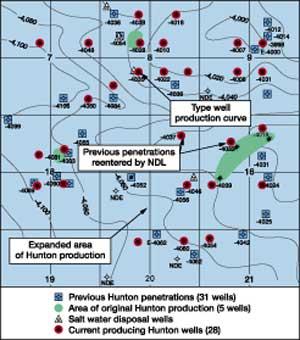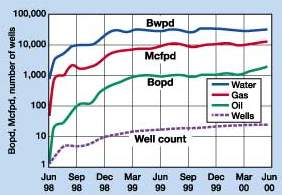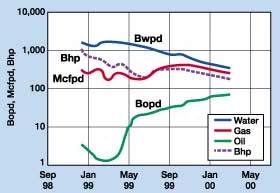Major reserve increase obtained by dewatering high-water-saturation reservoirs
Major reserve increase obtained by dewatering high-water-saturation reservoirsDavid Chernicky, New Dominion, L.L.C., Tulsa, Okla. Bottom line. New Dominion, L.L.C. has taken a bolder approach to developing major new reserves in exhausted oil and gas fields. By applying technology now accepted in coalbed methane production to very extensive, high-water-saturation oil and gas fields, reserves previously considered uneconomic have become profitable. Background. From its beginning in 1998, New Dominion, L.L.C. (NDL) has been focused on producing high-water-saturation reservoirs, such as the Hunton limestone in central Oklahoma. The Hunton is quite heterogeneous, producing by partial water drive. Except for selected wells on structural highs, wells encounter thick, but typically high-water-saturation zones. Wells in this environment had been conventionally produced and typically abandoned, or bypassed entirely, because of high water production and the economic factors associated with the same. However, New Dominion’s experience has proven that systematic dewatering of the entire reservoir, not just individual wells, results in synergistic interaction among wells, leading to decreasing water:oil ratio (WOR) as field development occurs. Development of new reserves in this environment requires the following six essential components:
NDL installs all of the electrical, production water, gas and even oil distribution and collection infrastructure in advance of drilling production wells, which can produce up to 6,000 bfpd per well. Once initial production is established, NDL begins an intensive and systematic development drilling program to systematically dewater and produce the entire reservoir. Identifying the reservoir. Fig. 1 depicts a portion of a field NDL developed in Lincoln County, Okla. This small area (4,800 acres) had experienced sporadic drilling over 30 years, which resulted in 31 penetrations of the Hunton limestone. Conventional production methods before New Dominion’s efforts had yielded only 37,552 bbl of oil and 482,901 Mcf of gas.
The operator re-analyzed the well data and, in less than two years, drilled or re-entered 28 new Hunton producers, thus developing proven recoverable reserves of 2.2 million bbl of oil and 16.2 Bcf of high-Btu gas. The field is still undergoing development and total reserves are expected to increase. Characteristic production. Production data for 28 wells through April 2000 is illustrated in Fig. 2. This field exhibited a relatively fast response time to dewatering efforts, as shown in this composite curve. The increase in oil cut (decrease in WOR) is evidenced by the convergence of the two individual curves. The gas volumes produced are quite extraordinary (nearly 14 MMcfd) and the gas is very rich, ranging from 1,150 to 1,600 Btu.
Fig. 2 emphasizes the dramatic difference in coalbed methane performance versus high-water-saturation, oil reservoir performance. That is, there are two income streams here, and no special tax incentives are required to justify technology development. Individual well payout occurs in less than half the time and ultimate return on investment is more than doubled. A typical well production curve for the field is shown in Fig. 3. This well was one of the first to be drilled and, when brought on in July 1998, it averaged 5 – 10 bopd and 300 Mcfd with 1,600 bwpd, utilizing a small submersible pump. Nothing mechanical was done to this well. The increase in well performance was due solely to the synergistic interaction of offset development wells as they were drilled, brought into production and dewatered the surrounding reservoir rock.
Within 16 months, this well was producing less than 600 bwpd and was placed on beam pump. Oil production increased to over 80 bopd, and gas production was in excess of 500 Mcfd. Initial WOR was 160:1, yet in only 16 months, the ratio had declined to 7.5:1, a 21-fold decrease. Well spacing was one well per 160 acres at this time, though the operator has recently increased well density to maximize recovery and present value of the investment. New Dominion’s staff has been developing these types of reservoirs for more than 17 years, providing them with insights on the physical processes at work and a wealth of practical operating experience. The company is working with two of Oklahoma’s major universities to better understand the reservoir processes at work with the goal of extending the technology application to other appropriate oil reservoirs. Wells and facilities. Unconventional production techniques require different production technology and expertise, both downhole and on the surface. Anticipating high fluid and gas volumes, 8-3/4-in. holes are drilled through the Hunton at depths ranging from 4,900 to 5,100 ft. Seven-in. casing is set and cemented 300 ft or more above the Hunton. Standard, triple-combo openhole logging suites (Dual Focused Induction, Compensated Neutron Density with PE and Microlog) are used to interpret reservoir quality. "Dry holes" are rare, since adequate well data to define the reservoir exists prior to drilling. Production casing is always on location at the time of logging. The entire zone is perforated at one shot per foot and treated with an acid / water frac (sand is used as a diversion agent). Good reservoir rock requires less stimulation than poor reservoir rock, just as in conventional production methods. To facilitate large fluid and gas volumes, 3-1/2-in. tubing is utilized. Typically, electric submersible pumps with dynamic operating ranges of 1,500 to 4,000 bfpd are installed. The horsepower of these pumps ranges from 100 – 250 hp. Wells are equipped, and offset wells drilled, in such a manner as to affect a 30 to 40% decrease in pumping bottomhole pressure within a reasonable amount of time. One of the greatest problems is the large quantity of gas produced with the oil-water mixture. Gas volumes can exceed 2 MMcfd per well and, with fluid rates in excess of 3,000 bwpd and 100 bopd, many complications, such as foaming, flowline restriction and fluid phase carry-over keep the field staff running at all times. Gas-fluid separation is accomplished with specially designed and fabricated high-volume, high-pressure gas separators placed at the wellhead and / or at the central production facility. Fluid phase (oil / water) separation is accomplished by specially designed and fabricated horizontal free water knockouts (FWKO). Chemical treatment is applied at the separation facility to accelerate and increase separation efficiency. There is no room for "poor boy" production techniques or equipment in this type of operation. All equipment is run at 100% load. Run time for new submersible pumps and tubing strings exceeds three years, but the fluid volumes usually decrease sooner, necessitating a pump change to either a smaller submersible pump or a beam pump. An operator must have total commitment to this type of operation to consistently utilize the downsized equipment inventory. Sometimes, when working around older fields, which may have experienced fluid injection, for either secondary recovery or for direct disposal use, H2S is encountered, and significant safety and costly chemical treatment programs must be implemented. Produced-water disposal facilities. High-capacity and efficient produced-water disposal wells are critical to this type of production operation and cost about $500,000 each. Typically, a 10-3/4-in. hole is drilled to the top of the Arbuckle limestone at 5,800 ft (800 ft below the Hunton). After running and cementing 9-5/8-in. casing, the entire Arbuckle column is drilled and completed open hole (2,000 ft). Then, 7-in. lined-casing is set as a tubing string and the well is capable of taking 15,000 – 20,000 bwpd on vacuum and in excess of 25,000 bwpd if equipped with a high-volume, low-pressure centrifugal pump necessary to overcome line friction in the tubing string. Produced water disposal well sites are selected in advance throughout the field. The number of wells needed to dewater one field depends upon:
A continual review of progress is required to optimize utilization of disposal facilities and maximize return on investment. Safety. The large volume of produced water mandates 24-hour monitoring of facilities and producing wells. Extensive electronic safety and automatic shut down systems are used for back up. New Dominion will be utilizing real time digital monitoring (SCADA) technology on future installations. Economic factors. Project economics are heavily influenced by:
In the 28-well Lincoln County project, total infrastructure investment exceeds $4 million, with 60% dedicated to produced-water facilities and the remainder to electrical construction. Completed well costs exceed $300,000 for direct costs, but average $500,000 if infrastructure is prorated to each well. Electricity comprises 60% of the $6,000/month average per-well lease operating expense.
|
||||||||||||||||||





